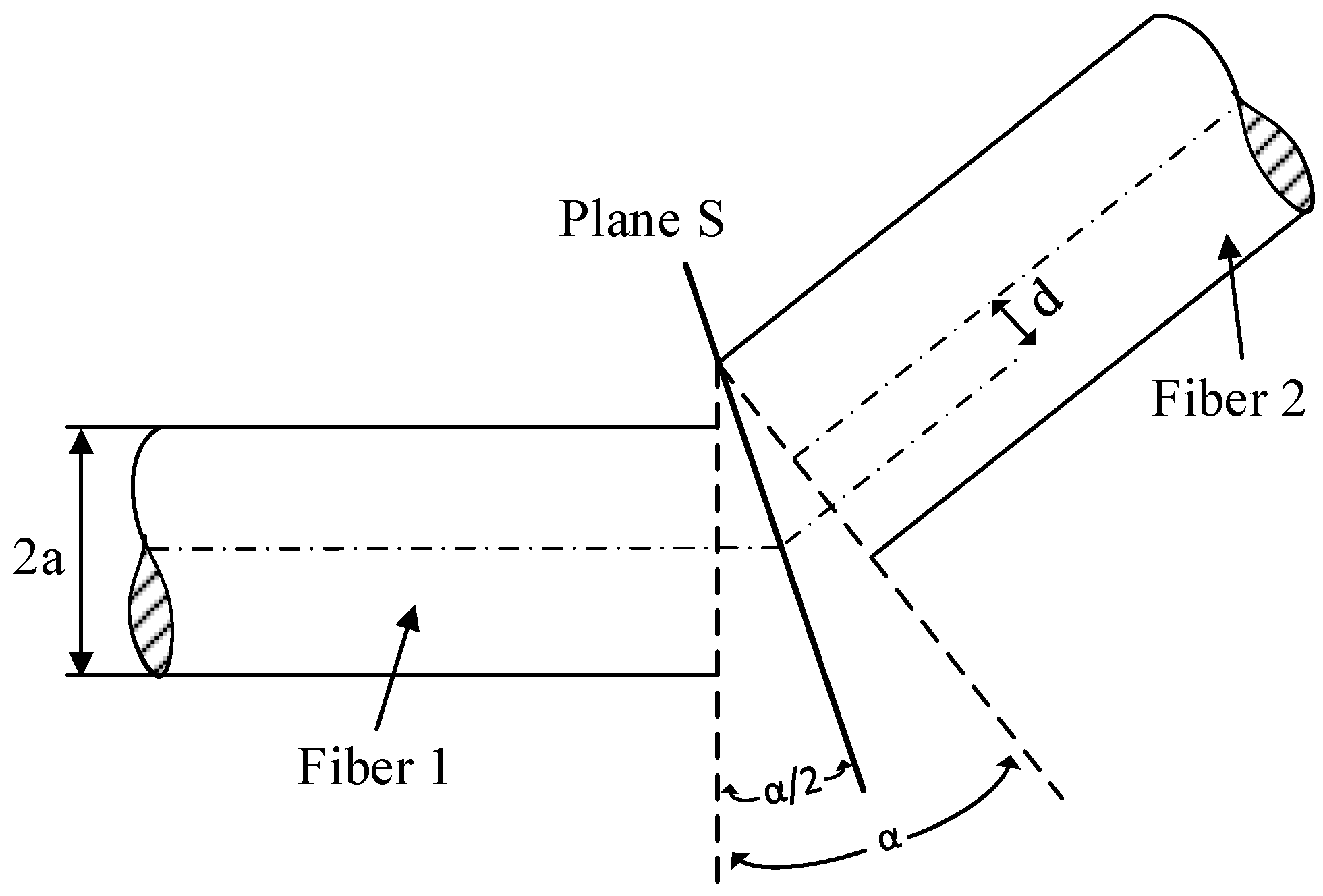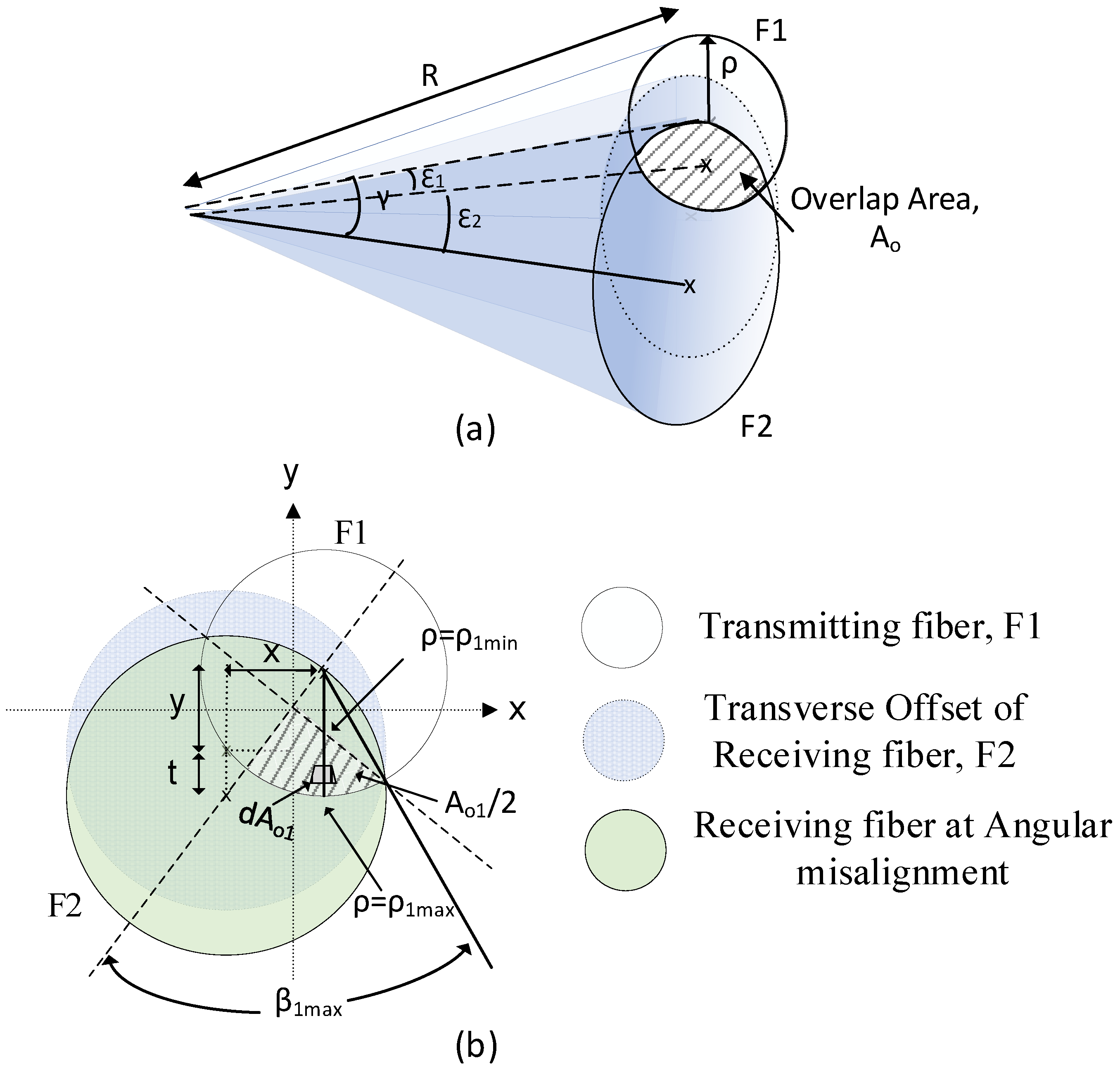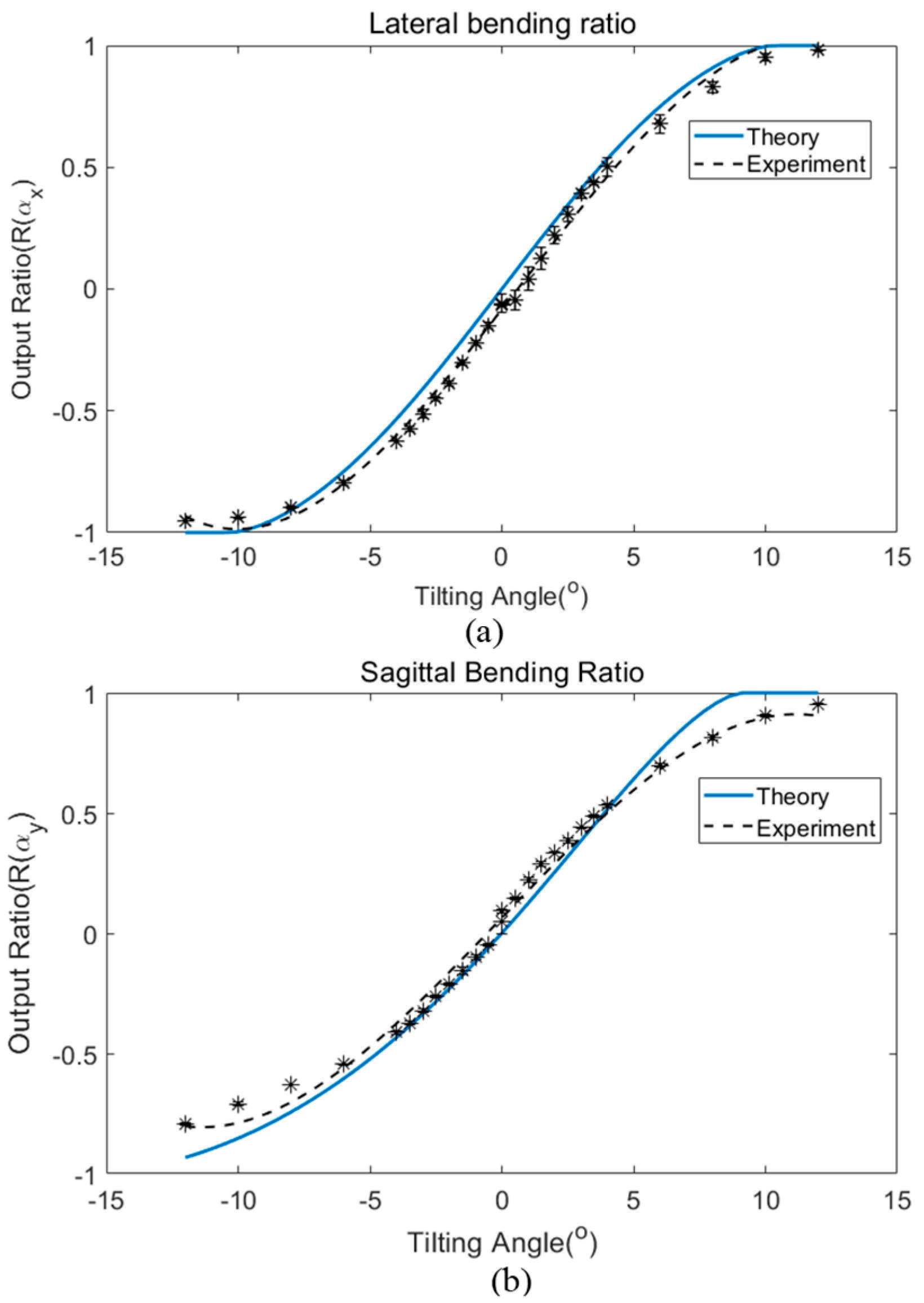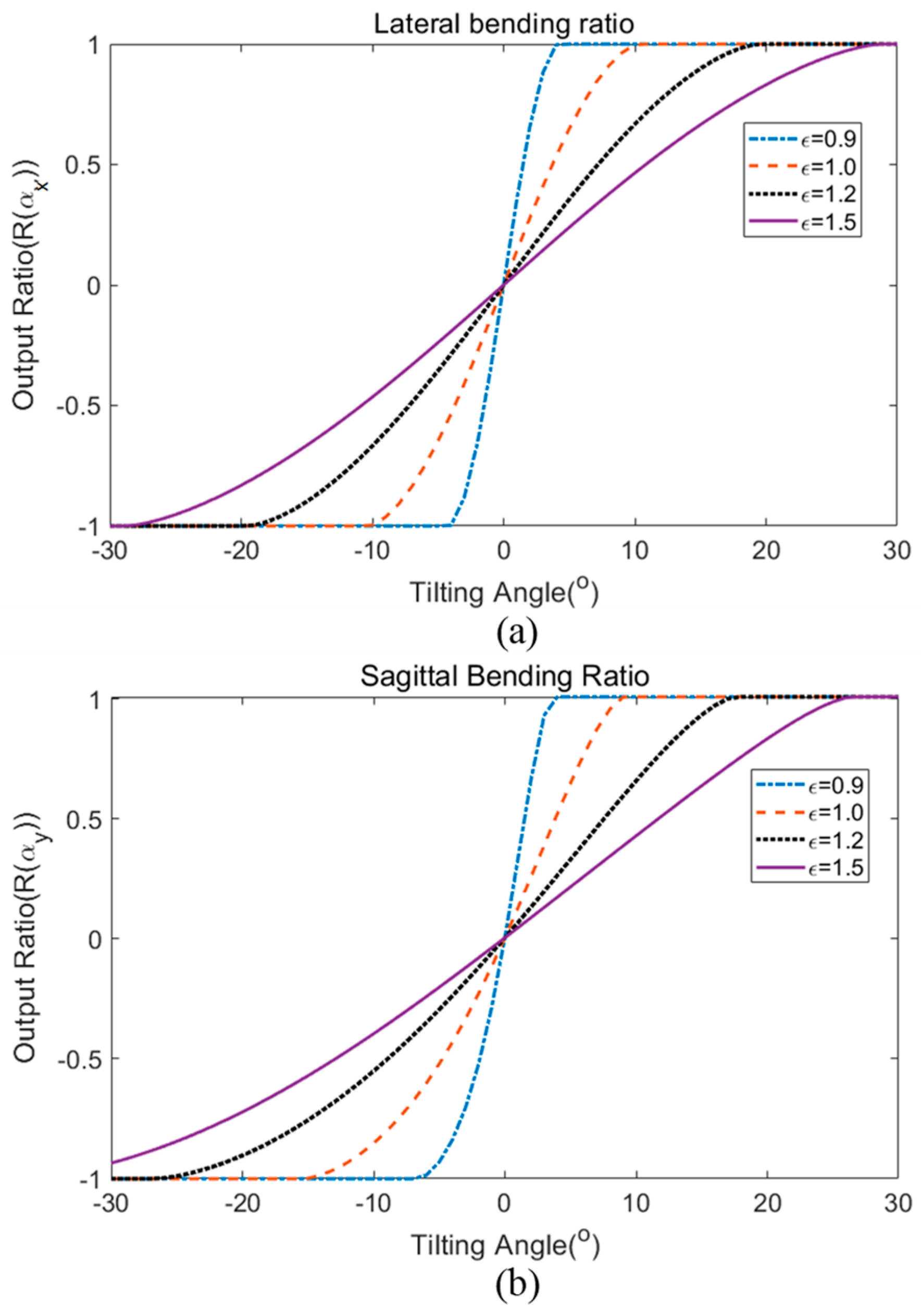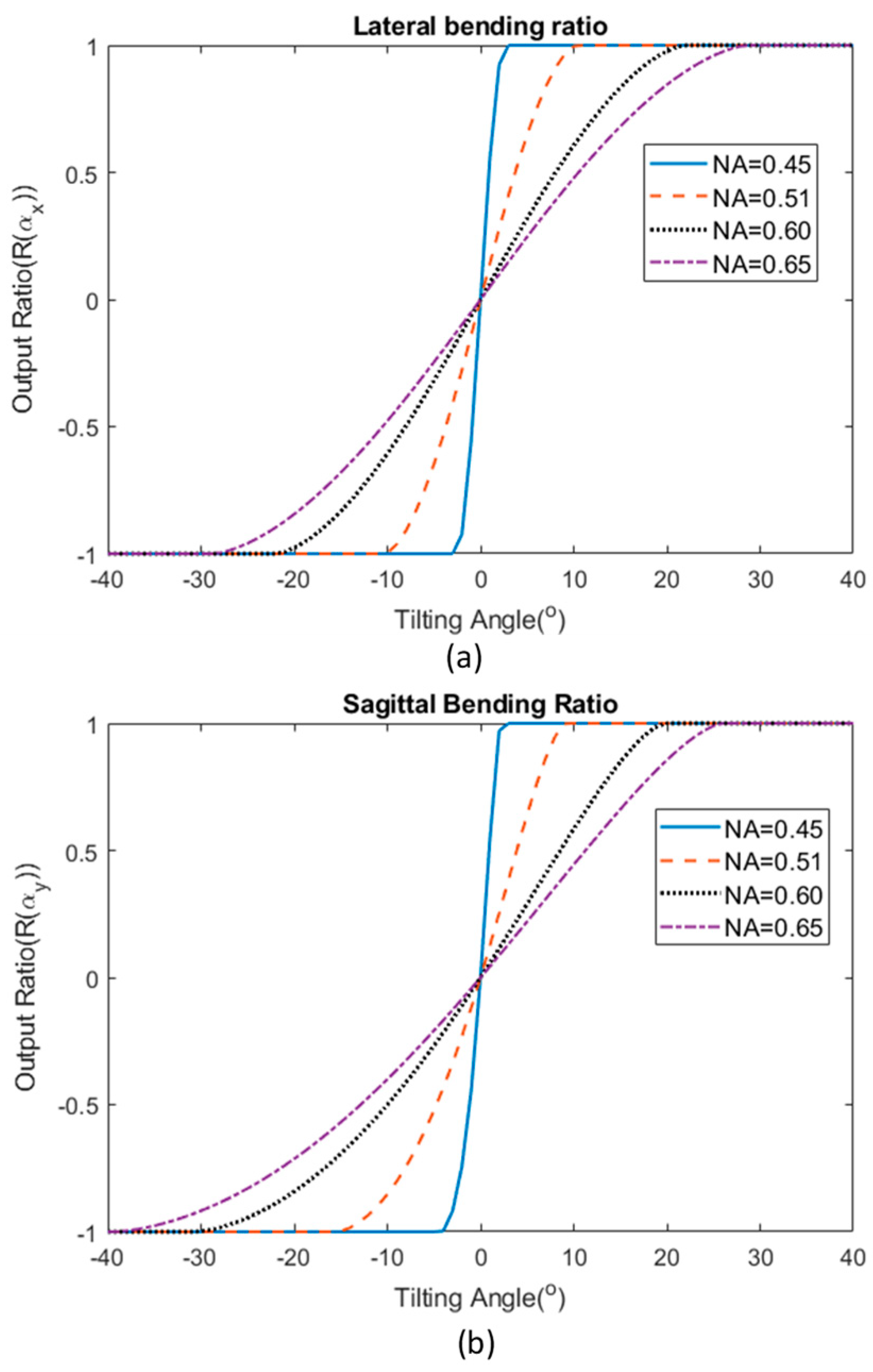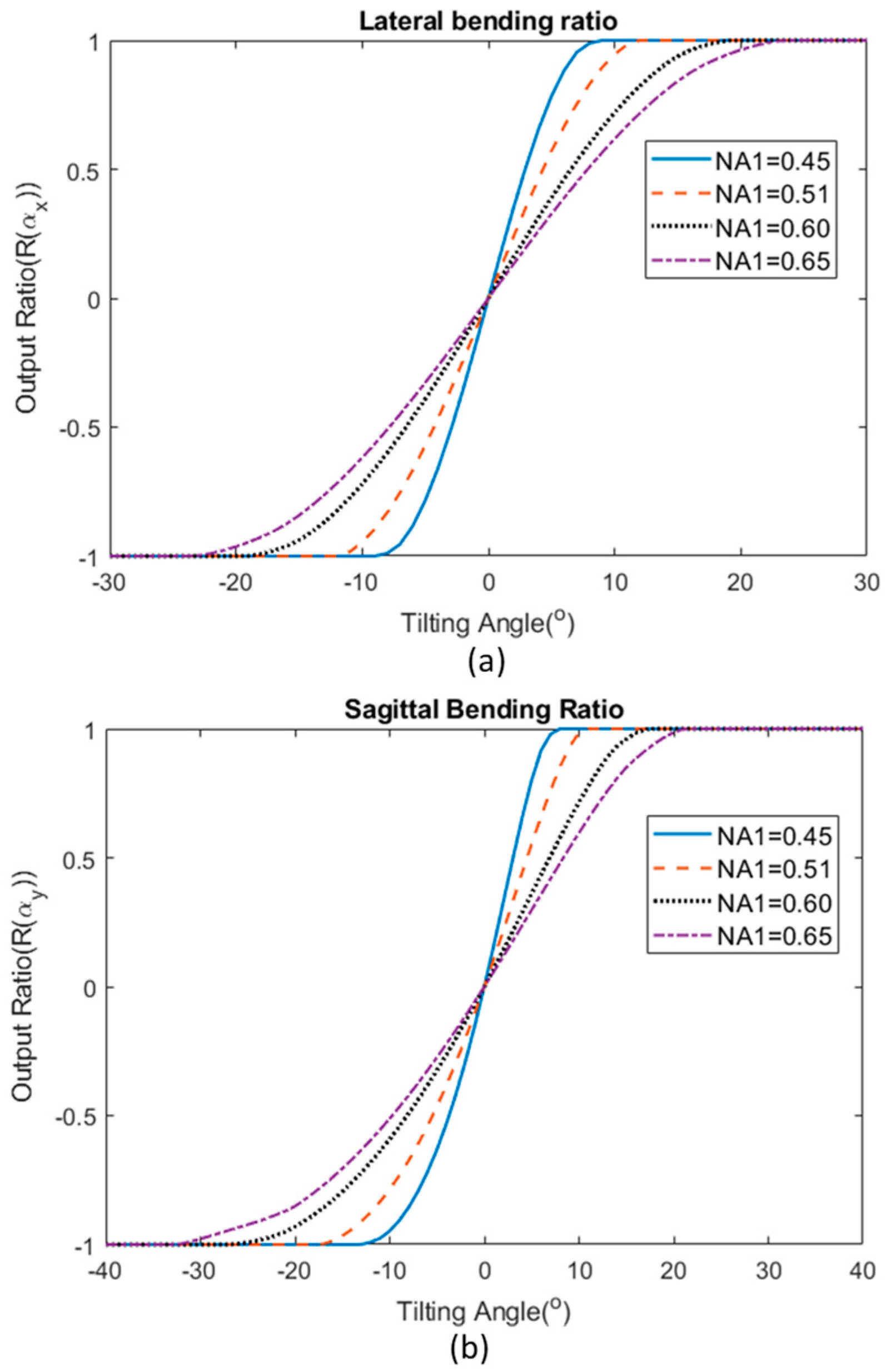1. Introduction
Optical fiber misalignment often occurs when joining two fibers in a permanent splice or using connectors. Transmission loss between connecting fibers can be due to intrinsic losses that are caused by a parameter mismatch between the fibers e.g., core diameter, numerical aperture (NA), different types (graded index or step-index). Extrinsic losses are incurred by geometrical misalignment of the fiber ends such as the presence of an air gap between the end faces [
1,
2], fiber tilt misalignment [
3] or radial offset [
4]. Provided the attenuation is limited at the plastic optical fiber (POF) connection, accurate estimation of the power coupling transmission between fibers can be achieved.
In some optical fiber sensors, geometrical misalignment between the fibers has been utilized as a basic configuration to modulate the light transmission for parameter detection [
5]. These sensors measured the parameter by allocating a fiber displacement in lateral, longitudinal, angular, or differential deviations and analyzing the changed of transmission loss [
6]. Sensors utilizing this measurement approach have also been implemented for the measurement of vibration [
7], temperature [
8], pressure [
9], displacement [
10,
11], and medical bending monitoring [
12,
13]. In all such cases, an accurate analytical calculation of the transmission power (loss) between the fibers is essential to evaluate the measurement parameters such as the range before developing the sensor.
For the case of the fiber based bending sensor of this investigation, multiple approaches have been previously developed using fiber optics. One approach involves the use of fiber Bragg grating (FBG) as the bending sensor where the external bending changes the pitch of the grating and thereby modulates the wavelength of the reflected light [
14,
15]. Another example of a bending sensor for monitoring seated spine posture was developed by Dunne et al. [
16]. A side abraded POF was used to allow light leakage from the polished region in order to detect spine motion. The same sensing technique using a side-polished optical fiber was also applied to design a knee sagittal monitoring sensor [
17]. Sensors using such designs have incurred the limitations of mechanical strength and bending at large angles or overstain, all of which result in permanent damage to the fiber sensor. Zawawi et al. [
18] also developed an intensity modulated fiber sensor for spine monitoring using an aluminum foil placed at the end tips between the input and output fiber to allow part of the source light to be reflected into reference fiber and partly transmitted to the output fiber. The sensor demonstrated accurate results but the long term stability of device was found to be inadequate for repeated use in a clinical setting.
A theoretical analysis of the power coupling loss due to angular misalignment has previously been presented by Opielka et al. [
19]. Gao et al. presented a similar angular misalignment analysis but with different numerical apertures (NA) between the input and output optical fibers used in sensing applications [
20]. The work described in this article presents a theoretical consideration of the geometrical optics to describe the power coupling between the multimode fibers when subjected to combined lateral and angular misalignment. In the second section, a POF sensor based on tilt angle loss between the source transmitting fiber and three axially misaligned receiving output fibers is introduced and experimental results are included. The development of the theoretical model to directly complement the experimental measurements obtained using a real sensor system as reported in this article is the first instance that such an approach has been reported in the case of a real clinical based sensor system [
21]. The results of the theoretical analysis formulated in the first section based on the optical fiber sensor configuration are directly compared with the experimental results. The theoretical investigation is significant as it facilitates the simulation of the parameters required for sensor based on transmission loss prior to fabricating the sensor. The result of the theoretical predictions is also beneficial for accurately calculating the transmission loss or power coupling between fibers with lateral and angular misalignment at the fiber coupling joint and hence determining the required sensor configurations for a wide range of other potential applications including structural monitoring and pressure monitoring.
3. Calculations
The power coupling efficiency received by fiber 2 was attributed to lateral and angular misalignment and calculated by integrating the solid angle Ω and overlap NA area at the plane S.
Figure 2 shows the overlapping light delivery and capture cones of both fibers where the shaded area is integrated using the defined parameters and geometry. Based on the principles of geometrical optics, the power coupling between multimode fibers attributed to lateral and angular misalignment can be derived step-by step as shown below. Generally, the power transmitted within fiber 2 may be written as follows [
19]:
where L is the radiance based on the power distribution in the plane S and
θ is the radiating area element within the overlap area from fiber 1. For the case of uniform power distribution,
L is constant in the overlapping region. Considering the inner integration of Equation (1), the power density,
P2′ is evaluated as:
where the definition of solid angle, Ω at the overlapping region is represented by:
where
Ao is the spherical surface area and
R is the radius of the considered sphere, (here referred to the length of the captured cone extended from the fiber) as shown in
Figure 2. Referring to
Figure 2b, the overlapping area of the solid angle (Ω),
for the NA value of the fibers (0.51) is integrated for each equal quadrant as the parameters shown in
Figure 2b:
where
β and
ρ are the angle and radius integration point limits of the one quadrant (shaded area) illustrated in
Figure 2b, and
θ is the angle between the extended radiating area and the cone axis of fiber F1.
For the case of combined transverse offset and angular misalignment coupling, the limit of the inner integral within the overlap area of one quadrant (hatched area) as illustrated in the
Figure 2b can be calculated as follows:
where
x is the transverse displacement in the x-axis for the input fiber F1,
y is the displacement in the y-axis for the input fiber F1, and
t is the displacement of the F2 cone on the plane S due to an angular misalignment (tilt) in the y-axis. Equations (7) and (8) are applied with the integral limit corresponding to the direction of angular misalignment in y-axis and x-axis, respectively. The other integral limits are as follows:
where
γ corresponds to the angle between the extended radiation at the lateral and angular misalignment and the normal of the emitting surface as presented in
Figure 2a.
θc is the maximum acceptance angle (critical angle) for both identical fibers and corresponds to the angle
θ in
Figure 2a. The integral limit β
max can be further simplified as follows:
Substituting the integration limits from Equations (9) to (12) and applying these to the overlap region of the solid angle (as represented in
Figure 2) into Equation (2), it is possible to express the power density as follows:
Substituting sin θ = ρ/R, the inner integration in power density equation can be replaced with the following:
A solution of Equation (13) using the integral limits defined above yields the following result:
The transmitted power in fiber 2 is found by integrating over the area element at the endface of the input fiber as follows:
The
rmax value represents the boundary radius where the acceptance cone of both fibers no longer overlap at the plane S due to lateral and angular misalignment. In the case of the solution for a step index fiber, the
rmax value is the radius of the multimode fiber,
a. Hence, the power coupling in fiber 2 including transmission loss due to transverse and angular misalignment may be written as:
Simplifying Equation (12) into:
and substituting Equation (19) into Equation (18), the power transmitted into fiber 2 may be expressed as follows:
The coupling efficiency is calculated as the ratio between received power in fiber 2 over the total power in the transmitting fiber, and is thus defined as follows:
3.1. Solution for a Two Step-Index Multimode Fibers of Different Numerical Aperture Values
This section discusses the case where both fibers have different Numerical Aperture (NA) values and where NA
1 < NA
2 and NA
1 and NA
2 represent the numerical aperture of fibers 1 and 2, respectively.
Figure 3 shows the overlapping of light delivery and capture cones of two fibers with different NA values when undergoing both lateral and angular misalignment. In this case, the quadrant of the overlapping cone (shaded area) is not equal, as illustrated in
Figure 3. It was necessary for the integration of the overlapping cones to be performed separately for quadrant areas 1 and 2. The integrated total power P
2 of fiber 2 is thus the sum of P
a1 and P
a2, where P
a1 is the transmitted power within overlap region 1 and P
a2 is the power within overlap region 2.
In this case, it is also necessary that the integration limits, β and ρ be evaluated separately for different overlapping quadrant areas by first evaluating the angles ε
1 and ε
2 as illustrated in
Figure 3a. The angle ε
1 represents the angle between the cone axis of transmitting fiber to the center axis of intersection plane between the overlapping cone (hatched area) and ε
2 is the angle between the cone axes of receiving fiber to the intersection plane between the overlapping cones. These angles are related to the angle between the extended radiation at the lateral and angular misalignment and the normal of the emitting surface, γ originally defined in Equation (10) as follows:
where
and
is the acceptance angle of fiber 1 and fiber 2, respectively. The value of γ is the sum of both ε
1 and ε
2 as illustrated in
Figure 3a. The value of ρ
min, ρ
max and β
max in Equations (9), (11) and (12) is thus replaced with ρ
1min, ρ
1max and β
1max for the determination of power of P
a1 and these quantities are defined below:
Substituting the integration limits from Equation (25) to (27) and applying these to the overlap region 1 (as represented in
Figure 3b), the power density P
2′ in Equation (13) is now written as Pa
1′:
Solving Equation (28) above yields the following result:
Through applying similar approach, the power density within the overlapping region 2 is expressed as follows:
Hence, the total power coupled into fiber 2 after summation of both integrals over the two different area element at the endface of the input fiber is thus rewritten as:
Assuming the input fiber has NA
1 and receiving fiber has NA
2, the coupling ratio in Equation (21) is defined as:
5. Results and Discussion
The power coupling ratio versus angular misalignment angle response was evaluated and compared with the corresponding theoretical calculation results obtained from Equations (35) and (36). In the theoretical representation of the POF sensor in this investigation, the power transmission for each output fiber was calculated using Equation (20). The transverse offset of each output fiber relative to the input fiber was considered in the theoretical calculation by substituting the coordinates of each output fiber, as illustrated in
Figure 4. The power ratio was plotted over the entire angular bending angle for lateral plane (x-axis) and sagittal plane (y-axis).
Figure 5 shows a comparison of the theoretical calculations and experimental results for angular bending in the lateral and sagittal planes.
For the theoretical analysis, the output ratio was calculated using the numerical aperture (NA) of the step-index multimode fiber with the value of 0.51 supplied as per the manufacturer’s specification data.
Figure 5 shows the trend of both bending measurements and both cases exhibit excellent agreement when compared with the theoretical values if modeled with a separation gap of 1.34 mm between the input and output fibers.
Table 1 summarizes the maximum and minimum deviation between the theoretical and experimental results across the working range plotted in
Figure 5. For lateral bending, the maximum deviation value was 0.0877 and occurs at the bending angle of −2°. The minimum deviation between both results occurs at 9° with the output ratio difference being as small as 0.0037 (absolute value). In the case of sagittal bending, the maximum deviation between the theoretical and experimental results is at the output ratio value of 0.12 that occurs at 9° of flexion. The minimum deviation between both results falls at 4° with an output ratio difference of 0.006 (absolute value). If the output ratio is offset to the range from zero to two, any percentage deviation between the theoretical and experimental results is calculated using the following equation:
The maximum deviation between the theoretical and experimental results are calculated to be 11.97% difference (at a −2° tilt angle) for the lateral plane and 6.04% (at 9° tilt angle) for the sagittal plane. The slight deviation between both results may be caused by human error during manual fabrication of the sensor.
In the experiment, the designated gap between the input and output fibers was set to be around 1.10 mm to allow some space for fiber bending. However, the separation (gap) between both tubes might extend a further small amount during the alignment process between both fiber tubes and during the bending. The useful operating angular range is between ±12° for both lateral and sagittal bending in the case of the sensor of this investigation, which was determined experimentally in reference [
22]. The bending angle beyond this working limit results in saturation of the sensor output.
Based on the theoretical calculation, the sensitivity and operating range of the sensor can be adjusted according to the inter-fiber separation gap (between input and output fibers) for other application purposes.
Figure 6 shows the result of theoretical calculation of varying the separation gap effect on the bending angle response. The output ratio was plotted against the bending angle for four different normalized gap ratios. The value of the normalized gap ratio, ε was calculated from the separation gap divided by the value 1.34 mm, which is the theoretical estimated gap that fits the response of the sensor fabricated in this investigation. For angular bending in both directions, a larger separation gap (higher normalized gap ratio) results in a larger sensing range. However, the sensitivity of the sensor is reduced as a compromise for a larger working range. For example, in the lateral bending ratio, the normalized separation gap ε of 1.5 constitutes a maximum operating range of ±29° but with a lower sensitivity response of 0.0466/1°. On the other hand, the output ratio of the sensor with normalized separation gap ε of 0.9 has a lower working range of ±5°, but with a higher sensitivity response of 0.2767/1°. From these theoretical calculations, the bending response of the sensor can be adjusted in the future depending on the desired operating range or sensitivity for a particular application.
Figure 7 demonstrates the response of the sensor using different NA of the multimode fibers. In order to calculate the response of the sensor’s output based on different NA of the step-index fiber used, other correlated parameters were assumed constant. The gap between both input and output fibers was fixed at 1.34 mm, which is the theoretical estimated gap that fits the response of the sensor fabricated in this investigation. The result shows that using a fiber with higher NA results in a higher working range (up to around ±30° for fibers with NA of 0.65) as the receiving fibers are still able to receive light from the input fiber even when tilted to a relatively high angle. However, the sensitivity is greatly reduced in this case. On the other hand, using a fiber optic with low NA will limit the operation range for the sensor, but provide a higher sensitivity.
Another aspect that can be considered in choosing the suitable parameters for the sensor is the case in which both input and output step-index multimode fibers have a different NA. For this analysis, the power coupling equation has been derived in
Section 3.1 and Equation (31) was used to calculate the total power coupled into each of the output fibers. Using a similar approach, Equations (33) and (34) were used to calculate the output ratio of a sensor for the two different bending axis.
Figure 8 illustrates the response of the sensor when the input fiber and output fibers have a different NA. NA1 represents the numerical aperture of the input fiber while NA2 remained fixed throughout the calculation study, which was 0.51 in this case. The sensor demonstrates a smaller operating range with a higher sensitivity when NA1 is small.
When the results of
Figure 8 are compared with
Figure 7, the case where NA1 < NA2 with NA1 = 0.45 and NA2 = 0.51 (blue line in
Figure 8) has a higher operating range of up to ±8° compared to the case when all fibers have NA of 0.45 (blue line in
Figure 7), which has a much smaller operating range of around ±3°. However, this value is smaller than the case where all fibers have the same NA of 0.51 (red dotted curve in
Figure 7) for which the operating range is ±10°. For the case where NA1 > NA2 (where NA1 is 0.60 and NA2 is 0.51), the sensor response (sensitivity and operating region) lie in between the case where all fibers have NA of 0.51 and 0.60. This allows the creation of more flexible options in selecting the right parameters for a particular application.
Using the theoretical model developed in this paper, these parameters can be used to more effectively and rapidly design the sensor for a given set of requirements. If the bending angle exceeds the working limit (high angular misalignment), this results in a saturation of the sensor output where the output fiber receives a negligible amount of light coupled from the input fiber. The theoretical study is therefore important for matching the sensor to the desired characteristic, such as the bending angle range or sensitivity, depending on the application.
